Trek’s Marlin is the brand's beginner-focused hardtail mountain bike, sporting 100mm of suspension travel.
It’s been updated for 2023 with a more progressive geometry, as well as some trail-oriented features such as the inclusion of a dropper seatpost.
The Marlin is also designed to double up as a commuter bike, with the inclusion of pannier rack and kickstand mounts.
Can the Marlin perform its double duty of providing a worthy platform for getting into mountain biking and cycling to work?
Trek Marlin 8 frame details
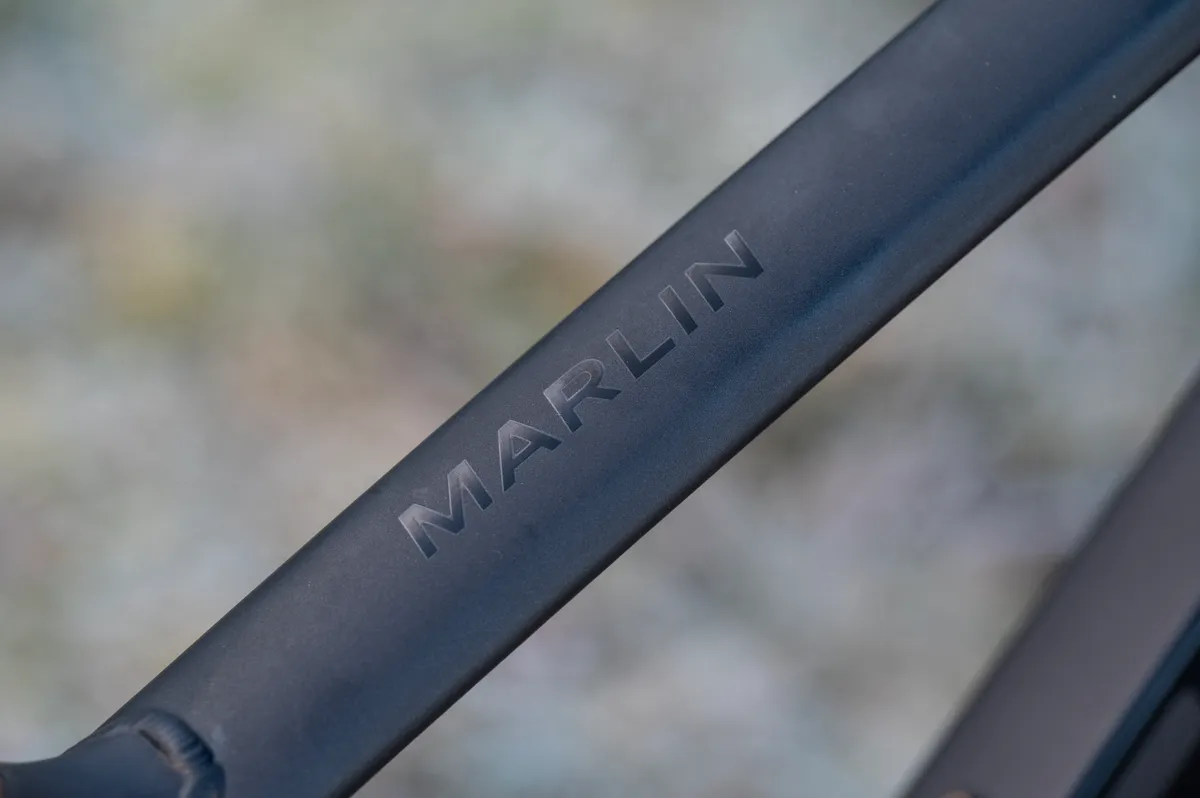
The third-generation Marlin uses Trek’s Alpha Silver aluminium, the heaviest and least sophisticated of Trek’s aluminium line-up, with Alpha Gold and Alpha Platinum sitting above it.
Compared to Gold and Platinum, Trek says Alpha Silver utilises less mechanical forming and hydroforming of the tubes. The brand claims the wall thickness of the tubes is more consistent.
The welds aren’t smoothed out as they are on the trail-oriented Trek Roscoe, but are still finished relatively neatly.
As Trek has slightly dropped the driveside chainstay, there’s now clearance for up to 29x2.4in mountain bike tyres when using a 1x drivetrain. You can use a front derailleur if you wish, but there isn’t routing for both this and a dropper post.
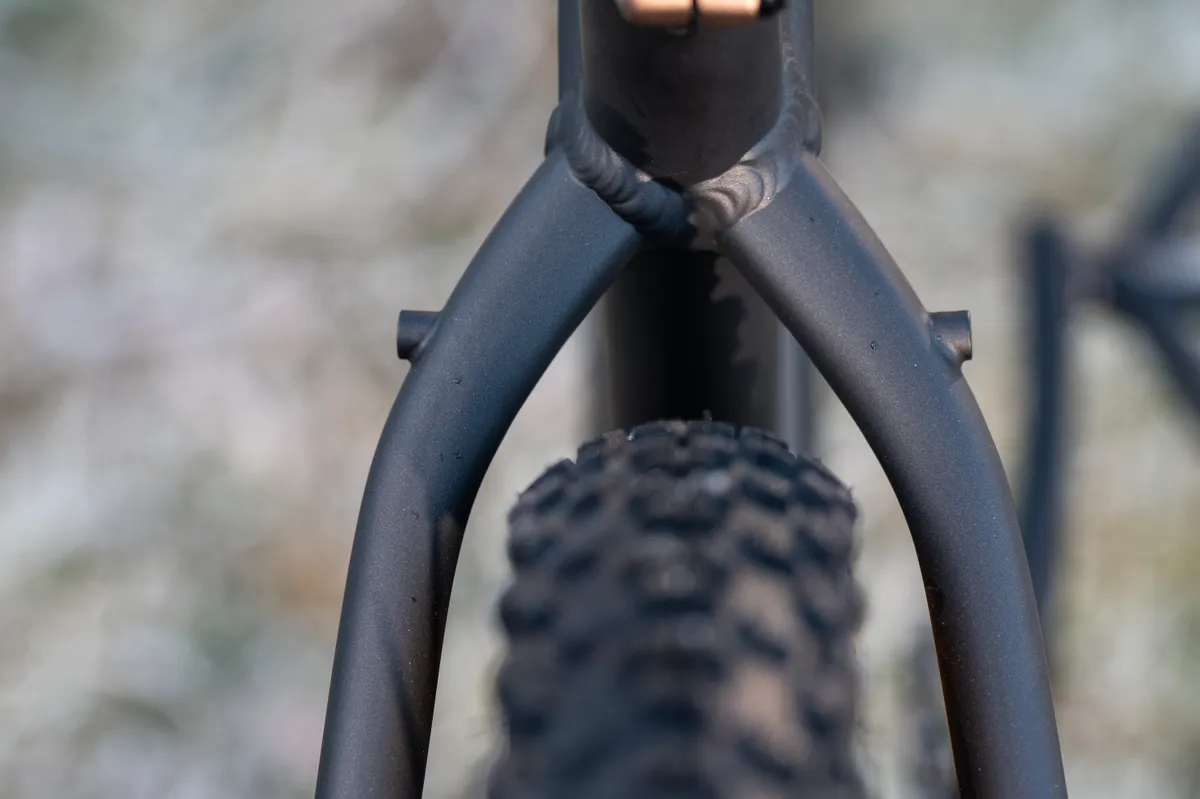
If you want to run a bigger fork, Trek says you can fit up to a 120mm-travel suspension fork on all sizes except the XXS. If you want to upgrade to a fork with a tapered steerer, you’ll need to also replace the headset because the steerer tube is a straight 44mm rather than tapered itself.
The Marlin features two bottle cages in the main triangle on sizes M upwards and runs on a BSA 73mm threaded bottom bracket.
The cables and rear hydraulic hose are routed internally through the down tube and then run externally along the underside of their respective chainstays.

On that note, there’s some well thought-out chainstay protection to silence chain slap on rougher trails.
Trek hasn’t forgotten the Marlin’s commuting roots and to that end, there are mounts for mudguards, a rack and kickstand.
Many of the latest mountain bikes use a thru-axle to secure the rear wheel.
Trek instead uses its 135x5mm Thru-Skew, which is effectively a quick-release skewer that installs into a threaded insert. The brand includes its Bontrager Switch lever to remove and install the skewer, so you don’t have to use a multi-tool every time.
It’s more secure than a conventional quick-release skewer because the dropouts are closed, which means the rear wheel cannot fall out if the skewer is loose. Also, in theory, the wheel will always be installed squarely into the frame and you shouldn’t have any issues with disc-brake alignment.

However, I’d have liked to have seen Trek just spec a thru-axle. This would make for a stiffer interface and ensure compatibility with the best mountain bike wheels if you ever wanted to upgrade. It’s not an unreasonable request at this price point either.
I asked if Trek considered speccing a thru-axle; it didn’t because it would have proved cost-prohibitive. The brand wanted to prioritise speccing a suitable fork and dropper post instead. Personally, I’d rather have a thru-axle than a dropper post, because that’s something you can always upgrade to down the line.
Trek Marlin 8 geometry

The geometry updates see the head tube slackened by a significant three degrees to 66.5. This is paired with a 74-degree effective seat tube angle, which has been steepened by a degree.
The Marlin also gets a longer reach, with a size large now measuring 470mm – 19mm longer than the equivalent size on the second generation. The effective top tube length has grown to 647mm from 638mm.
Although the Marlin retains its 438mm chainstay length, the wheelbase has lengthened, with a size large now measuring 1,197mm compared to 1,137mm.
It’s worth bearing in mind if you upgrade the fork to 120mm travel, it’ll slacken the head angle and shorten the reach.
Trek is offering the Marlin in sizes from XXS to XXL. The XXS is designed for junior and smaller riders, running on 26in wheels. The XS and S sizes use 27.5in wheels and sizes M through XXL use 29in wheels.
Sizes XXS and XS have a curved top tube and a lower standover height.
I found the size large an agreeable fit for my 5ft 11in / 180cm height.
| Frame size | XXS | XS | S | M | ML | L | XL | XXL |
|---|---|---|---|---|---|---|---|---|
| Wheel size (in) | 26 | 27.5 | 27.5 | 29 | 29 | 29 | 29 | 29 |
| Head tube angle (degrees) | 66.5 | 66.5 | 66.5 | 66.5 | 66.5 | 66.5 | 66.5 | 66.5 |
| Seat tube angle (degrees) | 74 | 73.8 | 73.8 | 73.4 | 73.4 | 73.4 | 73.4 | 73.4 |
| Effective top tube (mm) | 521 | 551 | 579 | 615 | 631 | 647 | 678 | 707 |
| Head tube length (mm) | 90 | 90 | 100 | 105 | 110 | 115 | 135 | 150 |
| Seat tube length (mm) | 320 | 340 | 370 | 420 | 435 | 450 | 500 | 540 |
| Chainstay length (mm) | 433 | 433 | 433 | 438 | 438 | 438 | 438 | 438 |
| Wheelbase (mm) | 1,060 | 1,092 | 1,121 | 1,163 | 1,180 | 1,197 | 1,230 | 1,261 |
| Reach (mm) | 365 | 390 | 415 | 440 | 455 | 470 | 495 | 520 |
| Stack (mm) | 544 | 563 | 572 | 609 | 614 | 618 | 637 | 651 |
Trek Marlin 8 specification
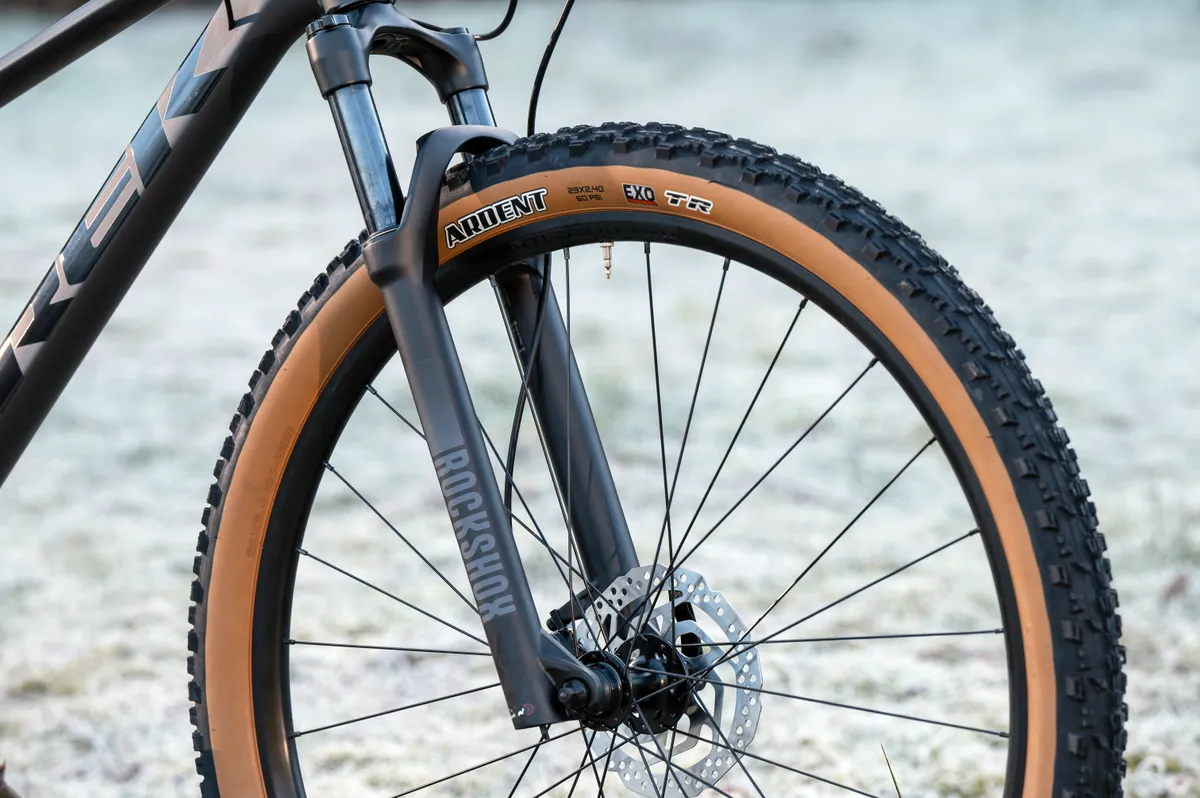
The Marlin 8 sits at the top of the range, with the 6 and 7 models below it. For £1,230, Trek has put together a reasonably robust and dependable package.
You get a RockShox Judy Silver fork with 100mm travel. The fork features an air spring, a lockout and rebound adjustment so you can set up the fork for your weight and riding style.
This makes for a significant difference over the coil-sprung forks found on some bikes at this price range, where making meaningful adjustments can prove harder to do.
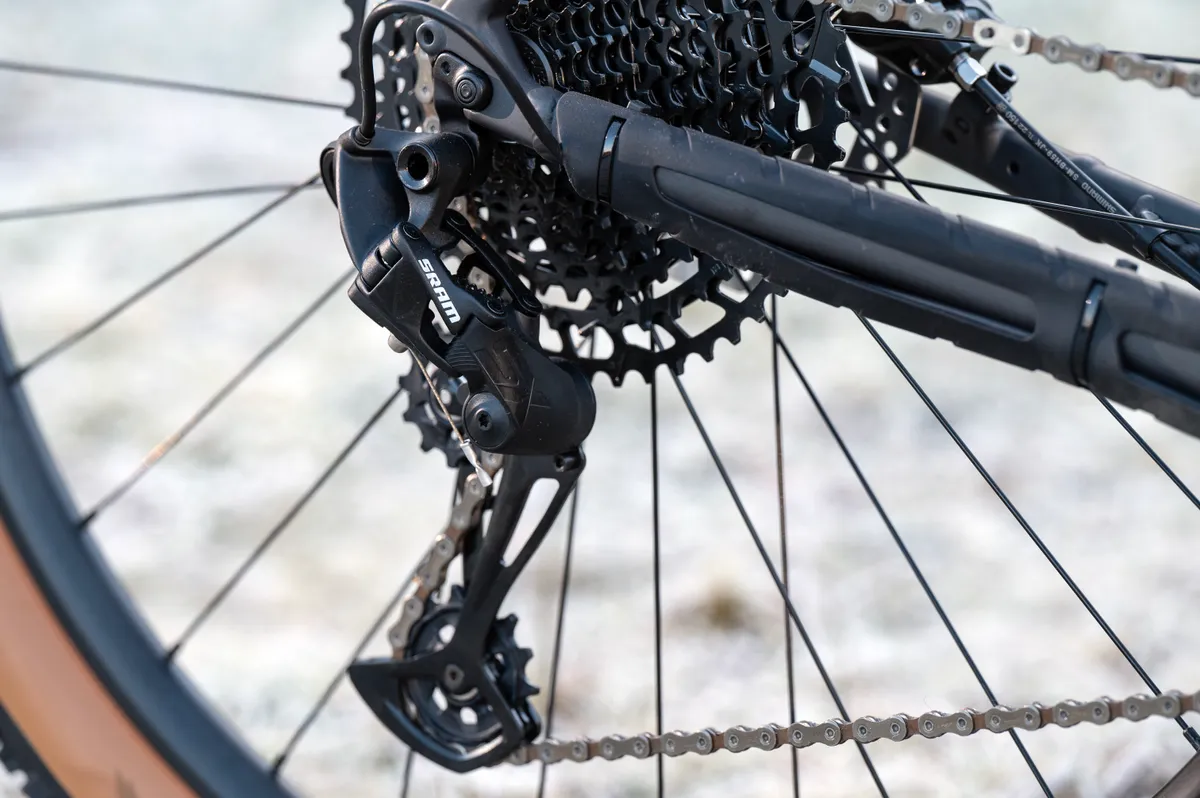
The drivetrain is SRAM’s SX Eagle, its entry-point 1x12 drivetrain with a wide-range 11-50t cassette. You don’t get the 10t cog found on the brand’s GX Eagle cassettes and upwards, because it requires the use of the XD freehub.
Still, the cassette range, in combination with the 30t chainring, is ample to winch your way up the steepest climbs and have fun on the descents.
SX cranksets use a Powerspline bottom bracket. This is similar to an ISIS or Octalink bottom bracket, with individual crank arms installing onto a 12-spline spindle.
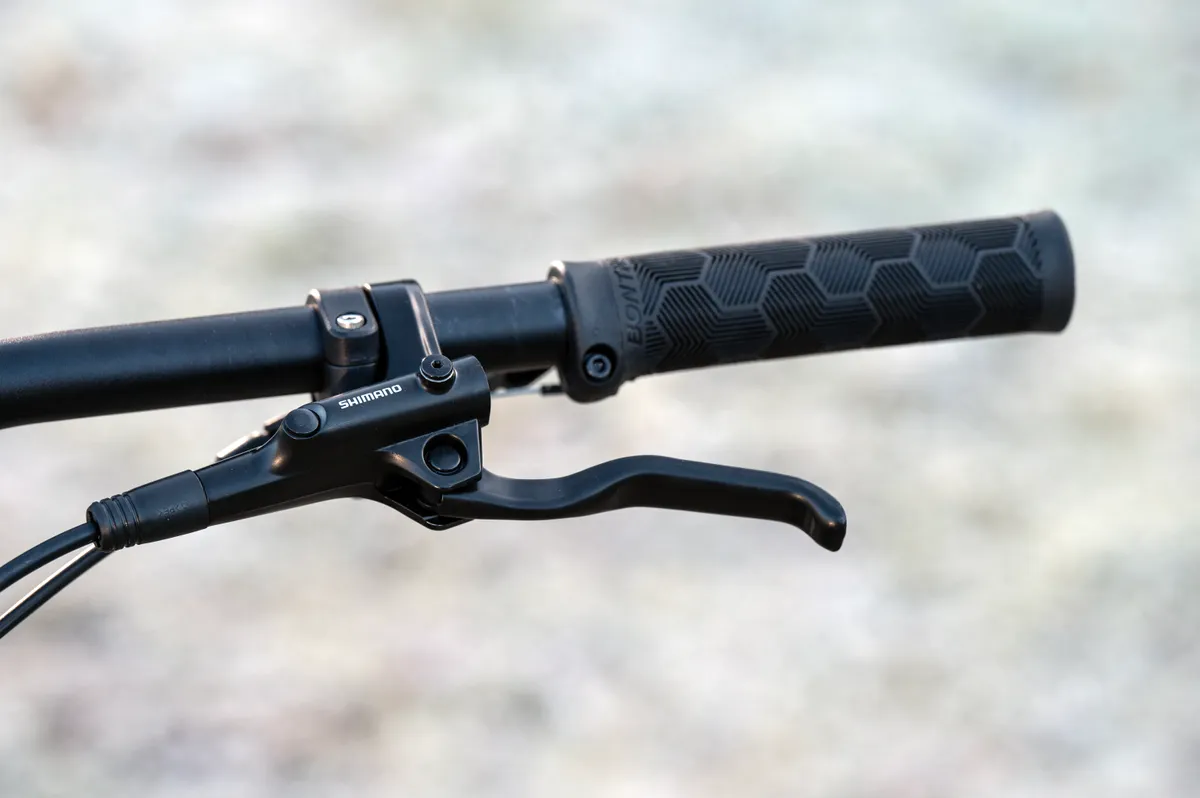
Shimano provides its MT200 hydraulic disc brakes. These are an untiered two-piston caliper and use a longer lever blade than the tiered equivalents, albeit with a reach adjustment feature. They also lack Shimano’s Servowave technology, which introduces a non-linear relationship between the lever and piston.
Most of the remaining spec is provided by Bontrager, Trek’s in-house brand. This includes the Kovee wheels, which have a 23mm internal rim width and are tubeless-ready. The 28-hole, double-walled Kovee rims are paired with Formula DC-20 and DC-22LW hubs.
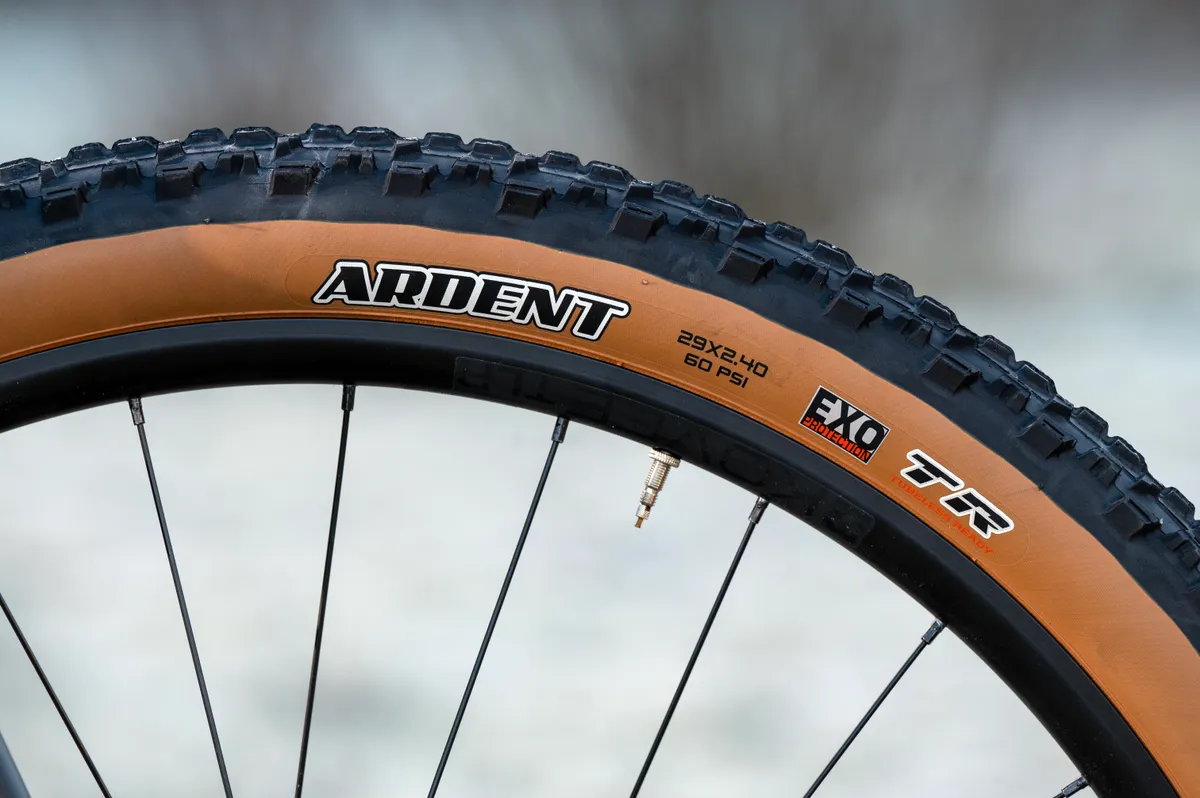
Trek has very shrewdly specced tubeless-ready, single-compound Maxxis Ardent tyres in a 29x2.4in width in its EXO casing. Because the rims come pre-taped, if you want to set the wheels up tubeless, it's simply a case of installing a tubeless valve and some sealant.
For comparison, both the Marlin 6 and 7 feature Bontrager KT3 tyres with a wired bead.
The handlebar and stem are from Bontrager too. The bars have grown to 750mm from 720mm and the stem is 30mm shorter at 50mm.
Trek has introduced dropper seatposts to the Marlin for the first time. The Marlin 8 features TranzX’s forgettably named JD-YSP18 dropper post and my size large uses a 150mm drop. The post doesn’t feature an option to adjust the drop.
Trek Marlin 8 ride impressions
I tested the Roscoe around the Forest of Dean and on some Cotswold trails between Bristol and Bath in the south west of England.
Trails ranged from flowing blues to steep and gnarly descents, although the majority of testing was spent on red-rated trails.
The trails were unseasonably dry for the winter, with only the occasional serving of gloopy mud and slop.
Suspension setup was reasonably straightforward. RockShox recommended 93psi as a starting point for the air pressure in the Judy fork, with the rebound set four clicks from closed.
I found the initial recommendation a little too firm, so let out a bit of air and settled on 87psi.
Trek Marlin 8 climbing performance

The Marlin 8 isn’t going to win any hill sprints, but it’s competent considering its asking price.
It’s on the heavy side at 14.56kg on the BikeRadar Scales of Truth, although it feels lighter when riding.
The seated pedalling position is fairly neutral, with the 74-degree effective seat tube angle putting you in a relatively efficient pedalling position. This is combined with the upright and relatively tall head tube. However, it’s worth bearing in mind the seat tube angle will realistically steepen by around 0.5 to 1 degree once the fork sags.
The seat tube angle could be even steeper though and I found I had to regularly shift my weight forward to negotiate steeper and more technical sections.
By sliding the saddle forward and sticking with the 50mm stem length, you shorten the effective top tube length (rather than the reach, which doesn’t change). I felt this also could have been a tad longer for my body composition.
If you decide to increase the stem length by 10mm, this will result in slower and less reactive steering, so it’s a bit of a double-edged sword.

However, perhaps Trek has stuck on the conservative side with the Marlin’s geometry, given it also needs to work as a commuter bike. On that basis and for those new to mountain biking, the geometry is a safe starting point.
The wider handlebars and shorter stem are a wise move and enable you to negotiate technical corners with flair.
I didn’t find the steel-railed Bontrager Arvada saddle a particularly comfortable perch when climbing, but saddle choice is personal.
I think Trek’s missed a trick by not speccing a remote lockout lever for the fork. I didn’t always find the TurnKey easy to reach for when pedalling and, given the bike is aimed at beginners, a remote lockout would have been more intuitive.
There’s already an element of cable spaghetti at the front, with four cables and hoses, so adding a fifth wouldn’t make much difference to the front-end aesthetic.
The Maxxis Ardent tyres are the highlight of the spec sheet and proved a proficient all-rounder in various conditions.
After some experimentation, I settled on 25psi on the front and 27psi at the rear for my 73kg weight. Grip is excellent and they walk a thin line between being robust and tacky. They dispatched wet and slippery root-infested trails with ease and stuck steadfastly to their line in muddier conditions.
I’d recommend setting the bike up tubeless if you’re going to be taking the Marlin to trail centres, so you can run lower pressures without worrying about pinch flatting. To do this, you will need to replace the rim tape (my test bike didn’t come with tubeless tape) and install a tubeless valve and sealant.

The SRAM SX Eagle drivetrain is functional but unremarkable. There’s some play in the shift lever before you initiate a gear change and the shifting quality doesn’t feel as solid as it could. Even with the rear derailleur B-gap set up correctly (SRAM Eagle systems are sensitive to this), the shifting isn’t the crispest under load.
A Shimano Deore drivetrain would have been a stronger spec choice, but at least the SX Eagle parts are cross-compatible with better components in the SRAM range, so there’s plenty of upgrade potential.
Trek Marlin 8 descending performance
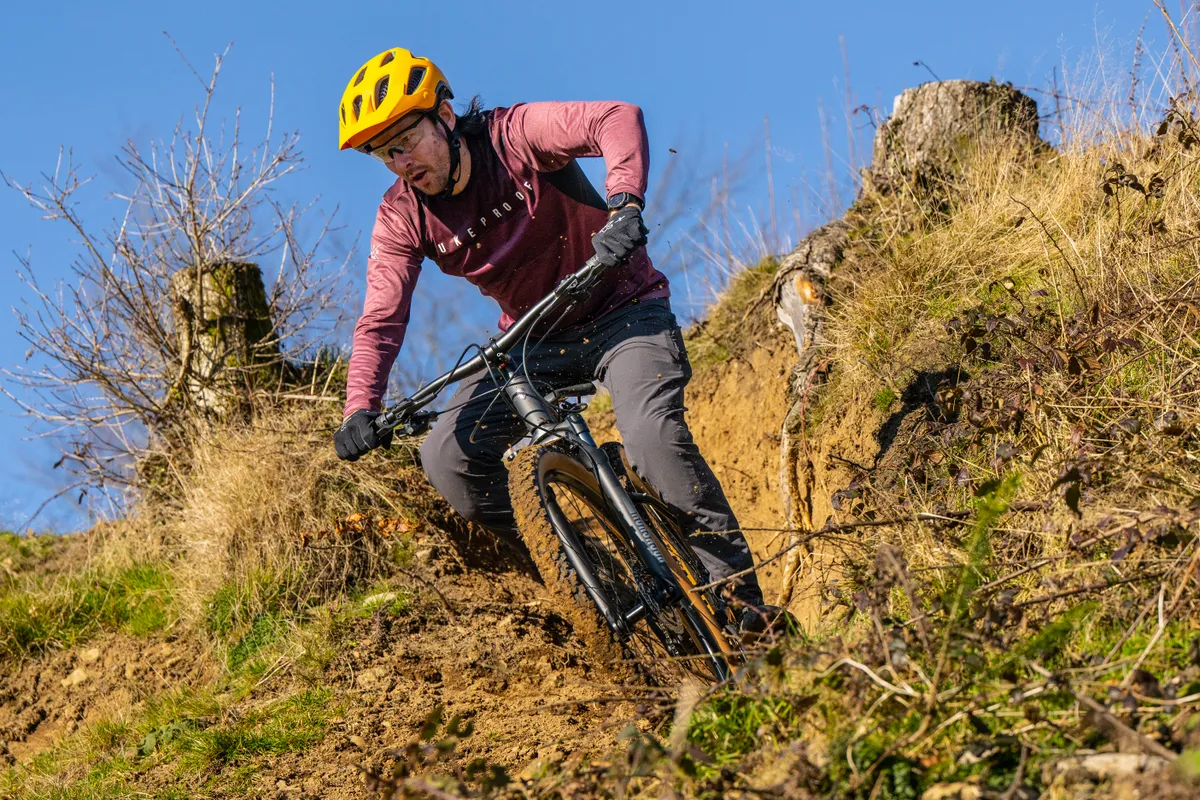
The Marlin 8 is, overall, a fun bike to ride, and proved competent in a range of scenarios. However, although befitting of its price point, it’s not the most confident descender on more technical terrain. That said, it’ll get you down most things you can throw at it, within reason.
While the Marlin will prove a hoot for recreational riding, it’s also surprisingly playful on graded trails once up to speed. The updated and more progressive geometry makes for calmer handling and it’s particularly well suited to fast, flowy trails.
Although the effective top tube length felt short when climbing, it wasn’t a negative when the trails pointed down.
The Judy Silver fork is fairly basic, but soaks up the chattery and root-infested trails reasonably well. It’s not as plush as other options in the range and it felt a bit twangy at times, lacking the smoother progression of a more expensive fork.
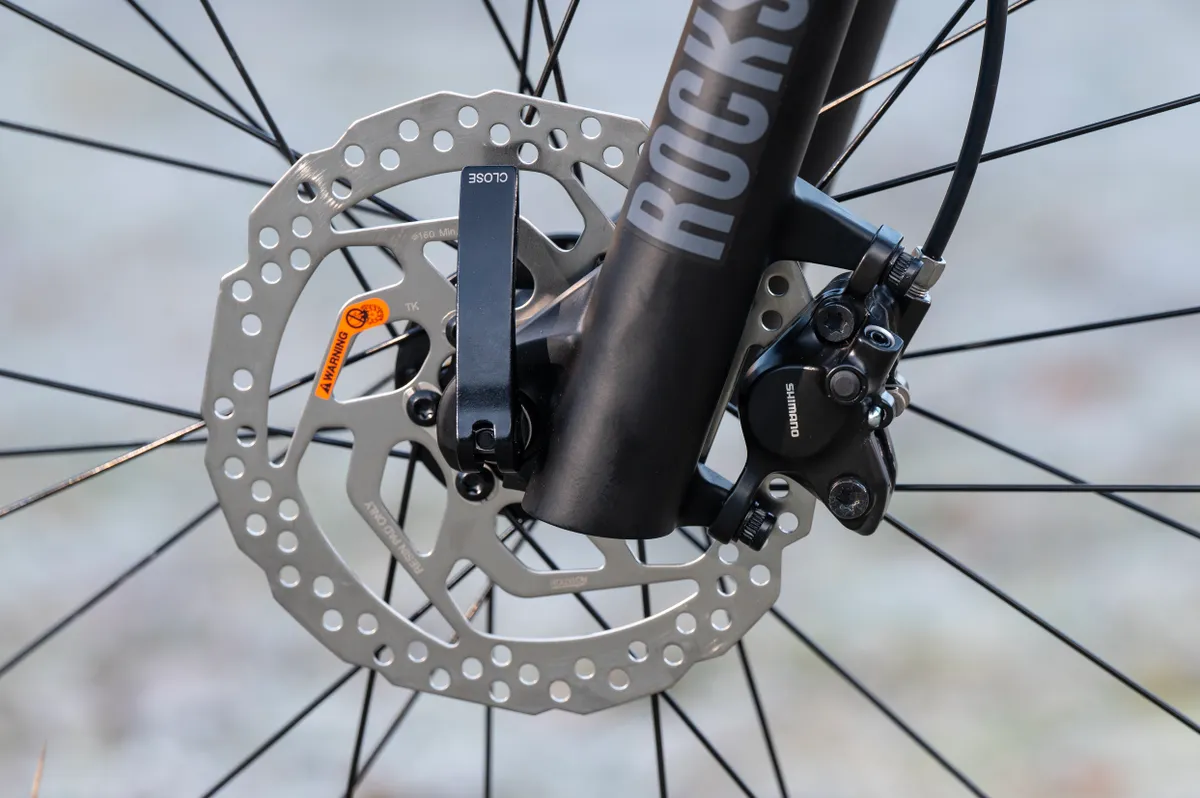
The front wheel doesn’t feel as stiff because the fork uses a quick-release skewer.
I also felt the Bontrager aluminium bars transmitted some unwanted feedback on the trails. I wasn't particularly enamoured with the Bontrager Trail XR lock-on grips either, although grips are another personal choice.
Despite being kept in a dry, indoor environment, I was disappointed to see the stem bolts starting to rust towards the end of the testing period.
The internal cable routing was also fairly rattly on more challenging terrain. My test bike didn’t have any cable ties, guides or a foam liner to quieten the cables in the down tube.
Trek says a foam liner is used on production bikes, so you shouldn’t experience this issue.
The Shimano MT200 hydraulic disc brakes are unremarkable and require more than one finger to come to a halt. Trek specs resin pads for the SM-RT26 resin-only disc brake rotor. If you’re looking for more bite and don’t want to upgrade the entire system, you could upgrade the rotor and disc brake pads to metallic.
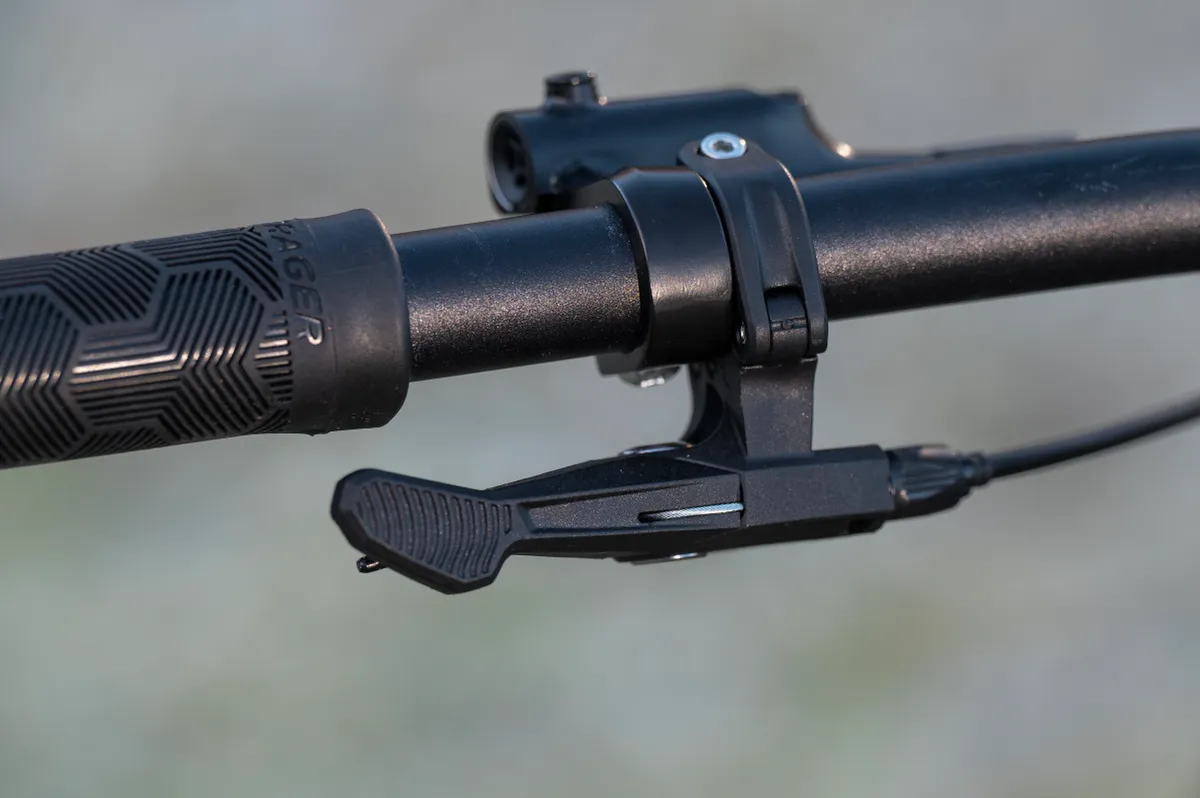
The TranzX JD-YSP18 dropper post performed soundly. The dropper lever feels rather plasticky in construction and there is a little flex, but lever actuation is smooth.
The post developed a bit of play towards the end of testing.
Trek Marlin 8 commuting performance
I also tested the bike on a handful of journeys to and from BikeRadar HQ, primarily on a paved cycle path, to test its commuting credentials. There are some cracked, pothole-filled roads at either end of the commute, as well as some city centre riding.
For this reason, mountain bikes can make for a compelling commuter bike option.
The Marlin 8 proved an adept performer and although the geometry isn’t as progressive as it could be on the trails, the more upright and shorter position is at home with utility riding.
The Judy fork smoothed out the bigger hits and the simplicity of a 1x drivetrain will make for easier maintenance.
The Maxxis Ardent tyres wouldn’t be my first pick for paved surfaces though, given they are quite tacky.
Trek Marlin 8 bottom line

Trek’s Marlin 8 is a solid performer, providing a fine gateway for those new to mountain biking.
It’ll prove a happy companion on green and blue trails, and will be competent on most elements of a red.
Trek has opted for a dependable component list and there’s nothing to stop you upgrading as you get hooked into the sport.
That said, the lack of a thru-axle at the rear limits upgrade potential, and if your ultimate goal is to ride more challenging trail centres, there are hardier choices out there.
The Marlin 8 will make for a versatile commuter if your route to work is predominantly off-road. Ultimately, it's a good first step into mountain biking that will put a smile on your face at not too great a cost.
Product
| Brand | Trek |
| Price | A$1899.99, €1349.00, £1230.00 |
| Weight | 14.56kg |
Features
| Fork | RockShox Judy Silver, Solo Air spring, rebound adjust, TurnKey hydraulic lockout, 42mm offset for 27.5in wheel, 100mm QR |
| Stem | Bontrager alloy, 31.8mm, Blendr-compatible |
| Chain | SRAM SX Eagle, 12-speed |
| Frame | Alpha Silver Aluminium, 135x5mm ThruSkew |
| Tyres | Maxxis Ardent, tubeless, EXO casing, folding bead, 60tpi |
| Brakes | Shimano MT200 hydraulic disc |
| Cranks | SRAM SX Eagle, 30T steel ring |
| Saddle | Bontrager Arvada, steel rails, 138mm width |
| Wheels | Bontrager Kovee rims on Formula DC-20 LW / DC-22LW hubs |
| Headset | Semi-integrated, 1 1/8 |
| Shifter | SRAM SX Eagle, 12-speed |
| Cassette | SRAM PG-1210 Eagle, 11-50t, 12-speed |
| Seatpost | TranzX JD-YSP18 |
| Grips/tape | Bontrager XR Trail Comp, nylon lock-on |
| Handlebar | Bontrager alloy, 31.8mm, 5mm rise |
| Bottom bracket | Truvativ Powerspline, 73mm, threaded cartridge, 118mm spindle |
| Available sizes | XXS, XS, S, M, ML, L, XL, XXL |
| Rear derailleur | SRAM SX Eagle |
